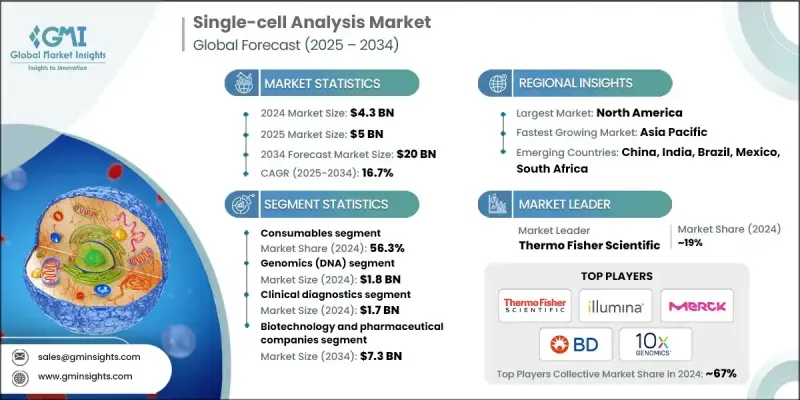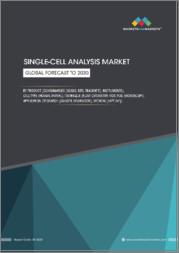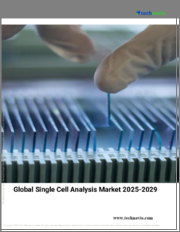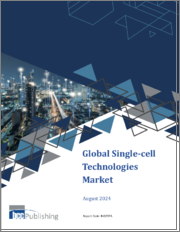
|
시장보고서
상품코드
1858816
단일 세포 분석 시장 : 시장 기회, 성장 촉진요인, 산업 동향 분석, 예측(2025-2034년)Single-cell Analysis Market Opportunity, Growth Drivers, Industry Trend Analysis, and Forecast 2025 - 2034 |
||||||
세계의 단일 세포 분석 시장은 2024년에는 43억 달러로 평가되었고, CAGR 16.7%로 성장할 전망이며, 2034년에는 200억 달러에 이를 것으로 추정되고 있습니다.

이러한 강력한 성장은 맞춤형 의료에 대한 관심 증가와 전사체학 및 유전체학 기술의 지속적인 발전이 원동력이 되고 있습니다. 단일 세포 분석을 통해 과학자는 복잡한 집단에서 개별 세포의 독특한 거동을 조사할 수 있으며 질병 진행, 약물 내성, 면역 반응 및 전이에 대한 깊은 이해를 얻을 수 있습니다. 이 기술은 희소암 세포의 검출, 치료 반응의 평가, 세포 이종성의 해명에 있어서 중요한 역할을 하고 있습니다. 전통적인 벌크 분석과는 달리, 단일 세포 기술은 종양의 진화, 드문 유전자 질환 및 세포 발달을 연구하는 데 매우 중요한 고해상도 데이터를 제공합니다. 샘플의 양과 감도가 낮기 때문에 이러한 방법은 매우 정밀한 프로토콜에 의존합니다. 전사체학, 에피유전체학, 단백질체학 및 대사체학를 단일 세포 레벨로 포괄하는 멀티오믹스의 통합은 세포 기능의 종합적인 이미지를 제공하는 데 도움이 됩니다. 게다가, 3D 공간 오믹스 기술의 진보에 의해 연구자는 본래의 조직 상황에서의 세포 상호작용 및 환경적인 단서를 탐색할 수 있게 되어, 생물학적 시스템에 대한 깊은 인사이트를 얻을 수 있어 진단, 창약, 재생 의료에 대한 용도가 진행됩니다.
| 시장 범위 | |
|---|---|
| 시작 연도 | 2024년 |
| 예측 연도 | 2025-2034년 |
| 시장 규모 | 43억 달러 |
| 예측 금액 | 200억 달러 |
| CAGR | 16.7% |
소모품 부문은 2024년에 56.3%의 점유율을 차지하였고, CAGR 16.9%의 성장률로 2034년에는 114억 달러에 달할 것으로 예측됩니다. 이 부문에는 단일 세포 워크플로우에 필수적인 시약, 비드, 분석 키트 및 마이크로플루이딕스 카트리지가 포함됩니다. 이러한 제품은 실험마다 소비되며 정기적으로 보충해야 하므로 지속적인 수요가 발생합니다. 줄기세포 생물학, 면역요법, 종양학과 같은 분야에서의 연구 빈도 증가는 특히 연구자가 학술 및 상업적 환경에서 실험을 확대함에 따라 소모품의 필요성을 부추기고 있습니다.
유전체학(DNA) 용도 분야는 2024년 18억 달러를 창출했습니다. 단일 세포 유전체학는 개별 세포 간의 유전적 차이를 검출하는 강력한 방법을 제공하며 염색체 변이, 돌연변이 및 클론 진화에 대한 인사이트를 제공합니다. 이 기술은 질병 메커니즘의 연구, 잔여 질환의 확인, 벌크 DNA 분석에서 간과될 수 있는 희귀 유전자 변이의 발견에 도움이 됩니다. 이 기술은 종양의 하위 집단을 추적하고 복잡한 조직의 유전자 구성을 이해하는 데 특히 유용합니다.
북미의 단일 세포 분석 2024년 점유율은 45.1%였습니다. 이 지역의 리더십은 연구개발에 대한 왕성한 투자에 기인하고 있으며, 특히 미국에서는 대기업 생명공학 기업과 제약 기업의 존재가 지속적인 기술 혁신을 지원하고 있습니다. 높은 의료 지출로 의료기관이 첨단 기술을 도입할 수 있는 반면, 학술 연구 거점과 임상시험 네트워크가 폭넓은 치료 영역에서 단일 세포 기술의 성장을 적극적으로 지원하고 있습니다.
세계 단일 세포 분석 시장의 주요 기업으로는 Illumina, Takara Bio, 10X Genomics, Sartorius, Oxford Nanopore Technologies, Thermo Fisher Scientific, Merck KGaA, Agilent Technologies, BGI Genomics, Fluidigm Corporation(Standard Bio Tools), NanoString Technologies, Novogene, Bio-Rad Laboratories, QIAGEN NV, and Becton, Dickinson & Company(BD) 등이 있습니다. 주요 기업은 단일 세포 분석 시장에서의 지위를 확고하게 하기 위해 유전체, 단백질체학, 공간 기술을 통합한 멀티오믹스 플랫폼을 포함한 제품 라인을 확충하고 있습니다. 또한 대규모 연구 프로젝트를 지원하기 위해 많은 기업들이 학술기관 및 바이오파머 기업과 파트너십을 맺고 있습니다. 연구개발 투자는 마이크로플루이딕스 공학, 시퀀싱 기술, 자동화 툴의 끊임없는 기술 혁신과 함께 핵심적인 초점이 되고 있습니다. 기업은 또한 수요 증가에 대응하기 위해 유통망을 강화하고 새로운 시설을 설립함으로써 세계적인 발자취를 늘리고 있습니다.
목차
제1장 조사 방법 및 범위
제2장 주요 요약
제3장 업계 인사이트
- 생태계 분석
- 업계에 미치는 영향요인
- 성장 촉진요인
- 맞춤형 의료에 대한 수요 증가
- 유전체학 및 전사체학 기술의 진보
- 암 연구에 있어서 용도 확대
- 정부 및 민간 자금 증가
- 업계의 잠재적 위험 및 과제
- 기기 및 시약의 고비용
- 복잡한 데이터 분석 및 해석
- 시장 기회
- 임상 진단의 확대
- 생명공학 및 제약 기업의 공동연구 성장
- 성장 촉진요인
- 성장 가능성 분석
- 규제 상황
- 북미
- 미국
- 캐나다
- 유럽
- 아시아태평양
- 라틴아메리카
- 중동 및 아프리카
- 북미
- 기술 및 정세
- 현재의 기술 동향
- 신흥 기술
- 파이프라인 분석
- 가격 분석
- 향후 시장 동향
- Porter's Five Forces 분석
- PESTEL 분석
제4장 경쟁 구도
- 서문
- 기업의 시장 점유율 분석
- 세계
- 북미
- 유럽
- 기업 매트릭스 분석
- 주요 시장 기업의 경쟁 분석
- 경쟁 포지셔닝 매트릭스
- 주요 발전
- 합병 및 인수
- 파트너십 및 협업
- 신제품 발표
- 확장 계획
제5장 시장 추계 및 예측 : 제품별(2021-2034년)
- 주요 동향
- 소모품
- 시약
- 분석 키트
- 장치
- 현미경
- 헤모 사이토미터
- 플로우 사이토미터
- 차세대 시퀀서
- 하이 컨텐츠 스크리닝 시스템
- 기타 기기
제6장 시장 추계 및 예측 : 분석 유형별(2021-2034년)
- 주요 동향
- 유전체학(DNA)
- 전사체학
- 에피유전체학
- 멀티오믹스 통합
- 기타 분석 유형
제7장 시장 추계 및 예측 : 용도별(2021-2034년)
- 주요 동향
- 임상 진단
- 연구
- 창약 및 의약품 개발
- 기타 용도
제8장 시장 추계 및 예측 : 최종 용도별(2021-2034년)
- 주요 동향
- 학술기관 및 연구기관
- 생명공학 및 제약기업
- 병원 및 진단실험실
- 기타 최종 사용
제9장 시장 추계 및 예측 : 지역별(2021-2034년)
- 주요 동향
- 북미
- 미국
- 캐나다
- 유럽
- 독일
- 영국
- 프랑스
- 스페인
- 이탈리아
- 네덜란드
- 아시아태평양
- 중국
- 인도
- 일본
- 호주
- 한국
- 라틴아메리카
- 브라질
- 멕시코
- 아르헨티나
- 중동 및 아프리카
- 남아프리카
- 사우디아라비아
- 아랍에미리트(UAE)
제10장 기업 프로파일
- 10X Genomics
- Agilent Technologies
- Becton, Dickinson & Company(BD)
- Bio-Rad Laboratories
- BGI Genomics
- Fluidigm Corporation(Standard Bio Tools)
- Illumina
- Merck KGaA
- NanoString Technologies
- Novogene
- Oxford Nanopore Technologies
- QIAGEN NV
- Sartorius
- Takara Bio
- Thermo Fisher Scientific
The Global Single-cell Analysis Market was valued at USD 4.3 billion in 2024 and is estimated to grow at a CAGR of 16.7% to reach USD 20 billion by 2034.

The strong growth is driven by increasing interest in personalized medicine and continued advances in transcriptomics and genomics technologies. Single-cell analysis allows scientists to examine the unique behavior of individual cells within complex populations, offering a deeper understanding of disease progression, drug resistance, immune responses, and metastasis. The technology plays a vital role in detecting rare cancer cells, assessing treatment responses, and uncovering cellular heterogeneity. Unlike conventional bulk analysis, single-cell techniques deliver high-resolution data that is crucial for studying tumor evolution, rare genetic disorders, and cellular development. Due to the low volume and sensitivity of samples, these methods rely on highly precise protocols. The integration of multi-omics covering transcriptomics, epigenomics, proteomics, and metabolomics at the single-cell level helps deliver a comprehensive picture of cell function. Additionally, advancements in 3D spatial omics technologies allow researchers to explore cellular interactions and environmental cues in their native tissue context, unlocking deeper insights into biological systems and advancing applications in diagnostics, drug discovery, and regenerative medicine.
| Market Scope | |
|---|---|
| Start Year | 2024 |
| Forecast Year | 2025-2034 |
| Start Value | $4.3 Billion |
| Forecast Value | $20 Billion |
| CAGR | 16.7% |
The consumables segment held a 56.3% share in 2024 and is forecasted to reach USD 11.4 billion by 2034, growing at a CAGR of 16.9%. This segment includes reagents, beads, assay kits, and microfluidic cartridges that are critical for single-cell workflows. As these products are consumed in every experiment and must be replenished regularly, they create ongoing demand. The increasing frequency of studies in fields like stem cell biology, immunotherapy, and oncology is fueling the need for consumables, especially as researchers scale up experiments in academic and commercial settings.
The genomics (DNA) application segment generated USD 1.8 billion in 2024. Single-cell genomics provides a powerful way to detect genetic differences between individual cells, offering insight into chromosomal variations, mutations, and clonal evolution. This technology is instrumental in studying disease mechanisms at a granular level, identifying residual disease, and uncovering rare genetic variants that may be overlooked in bulk DNA analysis. It is especially valuable in tracking tumor subpopulations and understanding the genetic makeup of complex tissues.
North America Single-cell Analysis Market held a 45.1% share in 2024. The region's leadership stems from strong investments in R&D, particularly in the U.S., where the presence of major biotech and pharmaceutical companies supports continued innovation. High healthcare spending enables institutions to adopt sophisticated technologies, while academic research hubs and clinical trial networks actively support the growth of single-cell technologies across a wide range of therapeutic areas.
Key players in the Global Single-cell Analysis Market include Illumina, Takara Bio, 10X Genomics, Sartorius, Oxford Nanopore Technologies, Thermo Fisher Scientific, Merck KGaA, Agilent Technologies, BGI Genomics, Fluidigm Corporation (Standard Bio Tools), NanoString Technologies, Novogene, Bio-Rad Laboratories, QIAGEN NV, and Becton, Dickinson & Company (BD). To solidify their position in the Single-cell Analysis Market, leading companies are expanding their product lines to include multi-omics platforms that integrate genomic, proteomic, and spatial technologies. Many are forging partnerships with academic institutions and biopharma firms to support large-scale research projects. Investment in R&D remains a core focus, with continuous innovation in microfluidics, sequencing technologies, and automation tools. Firms are also increasing their global footprint by enhancing distribution networks and establishing new facilities to meet growing demand.
Table of Contents
Chapter 1 Methodology and Scope
- 1.1 Market scope and definition
- 1.2 Research design
- 1.2.1 Research approach
- 1.2.2 Data collection methods
- 1.3 Data mining sources
- 1.3.1 Global
- 1.3.2 Regional/Country
- 1.4 Base estimates and calculations
- 1.4.1 Base year calculation
- 1.4.2 Key trends for market estimation
- 1.5 Primary research and validation
- 1.5.1 Primary sources
- 1.6 Forecast model
- 1.7 Research assumptions and limitations
Chapter 2 Executive Summary
- 2.1 Industry 360° synopsis
- 2.2 Key market trends
- 2.2.1 Regional trends
- 2.2.2 Component trends
- 2.2.3 Application trends
- 2.2.4 End use trends
- 2.3 CXO perspectives: Strategic imperatives
- 2.3.1 Key decision points for industry executives
- 2.3.2 Critical success factors for market players
- 2.4 Future outlook and strategic recommendations
Chapter 3 Industry Insights
- 3.1 Industry ecosystem analysis
- 3.2 Industry impact forces
- 3.2.1 Growth drivers
- 3.2.1.1 Growing demand for personalized medicine
- 3.2.1.2 Advancement in genomics and transcriptomics technologies
- 3.2.1.3 Growing applications in cancer research
- 3.2.1.4 Increasing government and private funding
- 3.2.2 Industry pitfalls and challenges
- 3.2.2.1 High cost of instruments and reagents
- 3.2.2.2 Complex data analysis and interpretation
- 3.2.3 Market opportunities
- 3.2.3.1 Increasing expansion in clinical diagnostics
- 3.2.3.2 Growth in biotech and pharma collaborations
- 3.2.1 Growth drivers
- 3.3 Growth potential analysis
- 3.4 Regulatory landscape
- 3.4.1 North America
- 3.4.1.1 U.S.
- 3.4.1.2 Canada
- 3.4.2 Europe
- 3.4.3 Asia Pacific
- 3.4.4 Latin America
- 3.4.5 Middle East and Africa
- 3.4.1 North America
- 3.5 Technology landscape
- 3.5.1 Current technological trends
- 3.5.2 Emerging technologies
- 3.6 Pipeline analysis
- 3.7 Pricing analysis
- 3.8 Future market trends
- 3.9 Porter's analysis
- 3.10 PESTEL analysis
Chapter 4 Competitive Landscape, 2024
- 4.1 Introduction
- 4.2 Company market share analysis
- 4.2.1 Global
- 4.2.2 North America
- 4.2.3 Europe
- 4.3 Company matrix analysis
- 4.4 Competitive analysis of major market players
- 4.5 Competitive positioning matrix
- 4.6 Key developments
- 4.6.1 Merger and acquisition
- 4.6.2 Partnership and collaboration
- 4.6.3 New product launches
- 4.6.4 Expansion plans
Chapter 5 Market Estimates and Forecast, By Product, 2021 - 2034 ($ Mn)
- 5.1 Key trends
- 5.2 Consumables
- 5.2.1 Reagents
- 5.2.2 Assay Kits
- 5.3 Instruments
- 5.3.1 Microscopes
- 5.3.2 Hemocytometers
- 5.3.3 Flow cytometers
- 5.3.4 Next generation sequencing
- 5.3.5 High-content screening system
- 5.3.6 Other instruments
Chapter 6 Market Estimates and Forecast, By Analysis Type, 2021 - 2034 ($ Mn)
- 6.1 Key trends
- 6.2 Genomics (DNA)
- 6.3 Transcriptomics
- 6.4 Epigenomics
- 6.5 Multiomics integration
- 6.6 Other analysis types
Chapter 7 Market Estimates and Forecast, By Application, 2021 - 2034 ($ Mn)
- 7.1 Key trends
- 7.2 Clinical diagnostics
- 7.3 Research
- 7.4 Drug discovery & development
- 7.5 Other applications
Chapter 8 Market Estimates and Forecast, By End Use, 2021 - 2034 ($ Mn)
- 8.1 Key trends
- 8.2 Academic and research laboratories
- 8.3 Biotechnology and pharmaceutical companies
- 8.4 Hospitals and diagnostic laboratories
- 8.5 Other end use
Chapter 9 Market Estimates and Forecast, By Region, 2021 - 2034 ($ Mn)
- 9.1 Key trends
- 9.2 North America
- 9.2.1 U.S.
- 9.2.2 Canada
- 9.3 Europe
- 9.3.1 Germany
- 9.3.2 UK
- 9.3.3 France
- 9.3.4 Spain
- 9.3.5 Italy
- 9.3.6 Netherlands
- 9.4 Asia Pacific
- 9.4.1 China
- 9.4.2 India
- 9.4.3 Japan
- 9.4.4 Australia
- 9.4.5 South Korea
- 9.5 Latin America
- 9.5.1 Brazil
- 9.5.2 Mexico
- 9.5.3 Argentina
- 9.6 Middle East and Africa
- 9.6.1 South Africa
- 9.6.2 Saudi Arabia
- 9.6.3 UAE
Chapter 10 Company Profiles
- 10.1 10X Genomics
- 10.2 Agilent Technologies
- 10.3 Becton, Dickinson & Company (BD)
- 10.4 Bio-Rad Laboratories
- 10.5 BGI Genomics
- 10.6 Fluidigm Corporation (Standard Bio Tools)
- 10.7 Illumina
- 10.8 Merck KGaA
- 10.9 NanoString Technologies
- 10.10 Novogene
- 10.11 Oxford Nanopore Technologies
- 10.12 QIAGEN NV
- 10.13 Sartorius
- 10.14 Takara Bio
- 10.15 Thermo Fisher Scientific



















